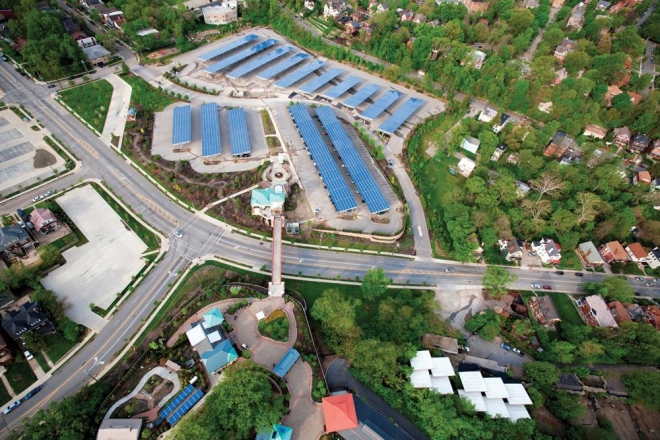Cincinnati Vice Mayor Roxanne Qualls (C) put forth a motion last week that calls on the mayor’s administration to establish new financing mechanisms for expanding the city’s solar energy capabilities.
Qualls says that she hopes the City of Cincinnati can work with local organizations like Green Umbrella, Port of Greater Cincinnati Development Authority, and the Greater Cincinnati Energy Alliance (GCEA) to develop Property Assisted Clean Energy (PACE) financing.
When City Council approved the Green Cincinnati Plan in 2008 it included a target of installing solar energy on one out of every five rooftops, both residential and commercial, by 2028. Qualls believes that working with GCEA and Green Umbrella will be critical in establishing a viable solar rooftop program and facilitating power purchase or lease agreements for solar energy installations that will be critical towards reaching 2028 benchmark.
“These are steps we can take now to help to not only save money on our energy bills today, but to build a globally-competitive local green economy and a lasting green legacy for our children,” stated Qualls.

The Cincinnati Zoo’s solar canopy is the largest publicly accessible urban solar array in the U.S. Image provided.
According to the vice mayor’s office, such a program would work by using third-party financing tools to overcome existing financial barriers for those interested in installing solar energy systems on their building. Similar programs are already in places around the nation, and Qualls believes a Cincinnati program could save consumers money on their utility bills, promote local jobs, and offer numerous environmental benefits.
“If Cincinnati adopted a goal to get 10% of its energy from solar by 2030, and just my small business met that demand, I’d have to hire 450 electricians tomorrow and keep them hired for the next 17years,” explained Matt Kolbinsky, Program Manager for SECO Electric.
The City of Cincinnati is already experiencing positive gains from its efforts to transition towards the use of green energy following the formation of an electricity buying group formed in 2012 that is now saving residential and small commercial users 23% on their monthly bills.
The electric supply contract put in place last April by the City also calls for 100% of the energy supply to be backed by Renewable Energy Credits. The move made the city one of the largest in the United States to do so, and earned it a spot as a finalist for the 2013 U.S. Earth Hour City Capital award.
The new motion, however, comes on the heels of a town hall meeting hosted by Xavier University’s Sustainability Committee, on the topic of solar energy, where more than 100 people attended. To capitalize on the momentum, Qualls has requested that the administration bring legislation on the matter back to council within 60 days.
“Cincinnati has all the right ingredients to go solar,” said Christian Adams, Clean Energy Associate for Environment Ohio who organized the town hall meeting last Tuesday. “From Findlay Market to the Cincinnati Zoo, the Queen City is leading the charge statewide for homegrown solar power and we can see that Cincinnatians are taking note of their city’s leadership on this issue.”
Green Umbrella has already established a Renewable Energy Action Team that has outlined how a residential solar rooftop program might work in Cincinnati, but the organization says that ongoing public feedback will be critical to future success.
“Building a solar powered Cincinnati is possible, but it will take all of us standing up to support these programs and calling for more,” Adams concluded. “Vice Mayor Qualls’ solar vision is striking a chord with Cincinnatians and people across the Queen City are waking up to the potential for a homegrown solar powered future right here in southwest Ohio.”
